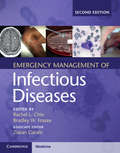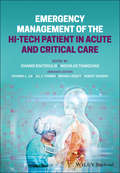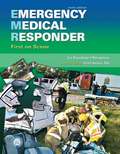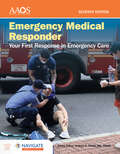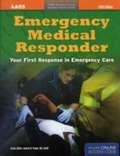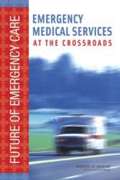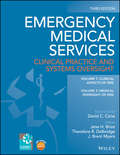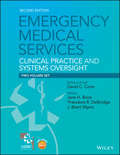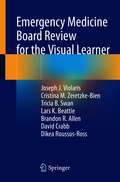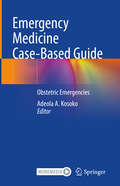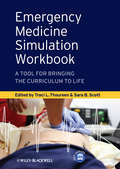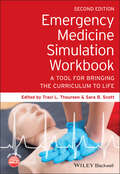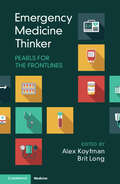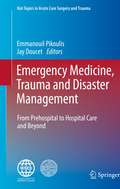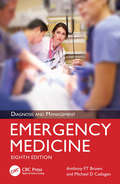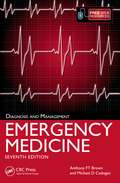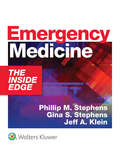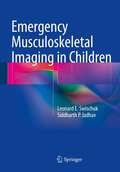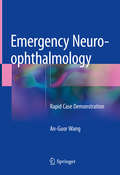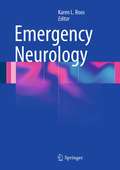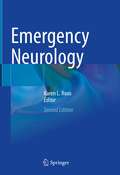- Table View
- List View
Emergency Management of Infectious Diseases
by Rachel L. Chin Zlatan Coralic Bradley W. FrazeeDiagnosis and management of infectious disease are among the most common and challenging aspects of emergency practice. Ranging from surgical treatment of a minor skin abscess to recognition of a rare tropical disease in a returning traveler to rapid resuscitation of a patient in septic shock, these problems will be familiar to every practicing acute care provider. Written by both infectious disease experts and practicing emergency physicians, this book is designed specifically for the acute care provider. It covers the most important pathogens and the most common clinical syndromes, organized by system and by special patient populations. The book features a comprehensive narrative, as well as high-yield tables covering key points on diagnosis and treatment. High quality color photographs assist with visual diagnosis. This book provides an invaluable resource for every practicing clinician who confronts the spectrum of infectious disease in the acute care setting.
Emergency Management of the Hi-Tech Patient in Acute and Critical Care
by Ioannis Koutroulis Nicholas TsarouhasEmergency Management of the Hi-Tech Patient in Acute and Critical care helps practitioners stabilize and care for pediatric and adult patients who have specialized medical devices such as prosthetic valves, cochlear transplants, insulin pumps, orthopedic hardware, and ventriculoperitoneal (VP) shunts. Using a step-by-step approach to acute presentations of patients with clinical hardware, this concise yet comprehensive guide provides specific instructions for the initial evaluation and management of numerous clinical scenarios including device malfunctions, infections, trauma, surgical complications, and more. Encompassing management of both the patient and the device, the guide enables emergency and critical care clinicians to rapidly make appropriate treatment decisions without the immediate need for extensive research, extended discussions with subspecialists, or recalling complex diagnostic and therapeutic algorithms. Clear, concise, and easy-to-follow chapters—written by a panel of highly experienced experts across specialties—include numerous algorithms, figures, tables, diagrams, and color illustrations and clinical images. An invaluable resource for improving the quality of care for the unique hi-tech patient population, this advanced practical manual: Provides algorithms for the most common clinical scenarios of device malfunction and related complications Covers management of patients who have undergone major operations such as organ transplantation or complex congenital heart disease repair Presents detailed management plans for a wide range of hardware types and medical conditions Offers expert guidance to practitioners in settings where not all specialties are readily available, such as rural and remote areas or community hospitals Features contributions from a team of experts in various areas of adult and pediatric emergency and critical care medicine Emergency Management of the Hi-Tech Patient in Acute and Critical Care is a must-have clinical reference and guide for pediatric and adult emergency medicine physicians, general pediatricians, internists, general practitioners, critical care specialists, and allied health practitioners.
Emergency Medical Responder: First On Scene
by J. David Bergeron Chris Le Baudour Keith WesleyFor courses in emergency medical responder programs. <P><P> Help students think like EMRs The leader in the field, Emergency Medical Responder: First on Scene provides clear, first responder―level training for fire service, emergency, law enforcement, military, civil, and industrial personnel. The text is based on the new National Emergency Medical Services Education Standards for Emergency Medical Responders and includes the 2017 Focused Updates from the American Heart Association Guidelines for Cardiopulmonary Resuscitation and First Aid. The fully updated 11th edition covers new topics recently introduced into emergency medical responder programs.
Emergency Medical Responder: First on Scene (Ninth Edition)
by J. David Bergeron Gloria Bizjak Chris Le Baudour Keith WesleyThe leader in the field, Emergency Medical Responder, Ninth Edition, provides clear first responder-level training for fire service, emergency, law enforcement, military, civil, and industrial personnel. The new ninth edition retains many successful features from previous editions and includes new topics and concepts that have recently become part of most Emergency Medical Responder programs. The foundation of this text is the new National Emergency Medical Services Education Standards for Emergency Medical Responder, and it also includes the 2010 American Heart Association guidelines for Cardiopulmonary Resuscitation and First Aid.
Emergency Medical Responder: Your First Response In Emergency Care
by American Academy of Orthopaedic Surgeons (AAOS)Based on the National EMS Education Standards and endorsed by the American Academy of Orthopaedic Surgeons, Emergency Medical Responder: Your First Response in Emergency Care, Seventh Edition clearly and concisely covers every competency required of students embarking on this vital EMS role.
Emergency Medical Responder: Your First Response in Emergency Care (5th Edition)
by David SchottkeUpdated to the new National EMS Education Standards and endorsed by the American Academy of Orthopaedic Surgeons, the fifth edition of our core first responder textbook, Emergency Medical Responder, continues to take an assessment-based approach to emergency medical responder training. Designed to meet the needs of law enforcement personnel, fire fighters, rescue squad personnel, athletic trainers, college students, and laypersons, The text and features found in the fifth edition will help students take the next step toward becoming outstanding Emergency Medical Responders.
Emergency Medical Services At The Crossroads
by Institute of Medicine of the National AcademiesEmergency Medical Services (EMS) is a critical component of our nation&#39s emergency and trauma care system, providing response and medical transport to millions of sick and injured Americans each year. At its best, EMS is a crucial link to survival in the chain of care, but within the last several years, complex problems facing the emergency care system have emerged. Press coverage has highlighted instances of slow EMS response times, ambulance diversions, trauma center closures, and ground and air medical crashes. This heightened public awareness of problems that have been building over time has underscored the need for a review of the U.S. emergency care system. Emergency Medical Services provides the first comprehensive study on this topic. This new book examines the operational structure of EMS by presenting an in-depth analysis of the current organization, delivery, and financing of these types of services and systems. By addressing its strengths, limitations, and future challenges this book draws upon a range of concerns: &#8226 The evolving role of EMS as an integral component of the overall health care system. &#8226 EMS system planning, preparedness, and coordination at the federal, state, and local levels. &#8226 EMS funding and infrastructure investments. &#8226 EMS workforce trends and professional education. &#8226 EMS research priorities and funding. Emergency Medical Services is one of three books in the Future of Emergency Care series. This book will be of particular interest to emergency care providers, professional organizations, and policy makers looking to address the deficiencies in emergency care systems.
Emergency Medical Services: Clinical Practice and Systems Oversight
by David ConeThe two-volume Emergency Medical Services: Clinical Practice and Systems Oversight delivers a thorough foundation upon which to succeed as an EMS medical director and prepare for the NAEMSP National EMS Medical Directors Course and Practicum. Focusing on EMS in the ‘real world’, the book offers specific management tools that will be useful in the reader’s own local EMS system and provides contextual understanding of how EMS functions within the broader emergency care system at a state, local, and national level. The two volumes offer the core knowledge trainees will need to successfully complete their training and begin their career as EMS physicians, regardless of the EMS systems in use in their areas. A companion website rounds out the book’s offerings with audio and video clips of EMS best practice in action. Readers will also benefit from the inclusion of: A thorough introduction to the history of EMS An exploration of EMS airway management, including procedures and challenges, as well as how to manage ventilation, oxygenation, and breathing in patients, including cases of respiratory distress Practical discussions of medical problems, including the challenges posed by the undifferentiated patient, altered mental status, cardiac arrest and dysrhythmias, seizures, stroke, and allergic reactions An examination of EMS systems, structure, and leadership
Emergency Medical Services: Clinical Practice and Systems Oversight, 2 Volume Set
by J. Brent Myers David Cone Theodore R. Delbridge Jane H. BriceEmergency Medical Services: Clinical Practice and SystemsOversight is the official textbook of the National Associationof EMS PhysiciansTM (NAEMSPTM) National EMS MedicalDirectors Course and PracticumTM.Now paired with a companion website featuring self-assessmentexercises, audio and video clips of EMS best practices in action,and more, this essential study aid guides students through the coreknowledge they need to successfully complete their training andbegin their careers as EMS physicians.Emergency Medical Services: Clinical Practice and SystemsOversight consists of:Volume 1: Clinical Aspects of EMSVolume 2: Medical Oversight of EMSCompanion website featuring supportive self-assessmentexercises, audio and video clips
Emergency Medicine Board Review for the Visual Learner
by David Crabb Lars K. Beattie Tricia B. Swan Brandon R. Allen Joseph J. Violaris Cristina M. Zeretzke-Bien Dikea Roussos-RossThis state-of-the-art book provides a concise and up-to-date review of key emergency medicine topics in a predominantly visual format along with extensive practice questions to assist in preparing for the emergency medicine board exams. It is comprised of numerous illustrations, created by Dr. Joseph Violaris, which are specifically tailored toward the visual learner studying and preparing for board exams in emergency medicine. The book is organized by organ system, with chapters on ophthalmology, cardiology, pulmonology, gastroenterology, nephrology, orthopedics, immunology, and more. Special chapters that conclude the book are dedicated to trauma, pediatrics, toxicology, environmental disorders, and epidemiology. Each chapter contains a visual learning guide followed by board practice questions at the end to reinforce topics addressed in the illustrations. Emergency Medicine Board Review for the Visual Learner is an essential guide for medical students, residents, and fellows in emergency and internal medicine studying for board exams as well as EM physicians and related professionals preparing for recertification.
Emergency Medicine Case-Based Guide: Obstetric Emergencies
by Adeola A. KosokoThis book provides a case-based approach to diagnosing, stabilizing, and facilitating the next steps for optimal care for peripartum and newborn patients. Hundreds of women die annually in the United States due to pregnancy or its complications, yet about 80% of these deaths are preventable. This book aims to improve outcomes by providing simple and memorable context to help guide diagnosis and management of peripartum and newborn emergencies, which will be valuable for just-in-time learning and studying. This book is structured into three major sections: early pregnancy emergencies, late pregnancy emergencies, and neonatal emergencies. This helps facilitate “can’t miss” differential diagnoses based initially on timing during the peripartum period. Each chapter presents a true-to-life case based on emergencies managed by the author, a skilled physician trained in emergency or pediatric medicine. Each case will walk the reader through details of a patient that presents to the emergency department, how to uncover the ultimate diagnosis, and how to care for the patient. Each case will include relevant radiographic images or algorithms. Authors have also provided tips and tricks to help uncover a diagnosis and to manage an obstetric emergency even with limited resources. Emergency Medicine Case-Based Guide: Obstetric Emergencies is meant to strengthen emergency physicians in their patient care and improve the outcomes of mothers and babies.
Emergency Medicine Oral Board Review Illustrated
by Yasuharu Okuda Bret P. NelsonThe accreditation process for emergency medicine in the United States is considered one of the most difficult among all medical specialties, with residents required to pass both a written and oral examination to gain certification. This book allows the reader to apply a case-based interactive approach to studying for the oral board examination, while also providing an excellent introduction to the field. Featuring more than 100 cases derived from the Model of Clinical Practice of Emergency Medicine, with an emphasis on EKGs, CT scans, x-rays, and ultrasounds, this book is a model resource for the practicing emergency medicine resident. The reader can easily practice cases alone or with a partner and can follow up with key points of critical actions, clinical pearls, and references. The appendix is loaded with high-yield information on subjects emphasized in the oral board examination, such as pediatric, cardiovascular, traumatic, and toxicologic disorders. This book truly allows the reader to feel actively immersed in the case.
Emergency Medicine Oral Board Review Illustrated
by Yasuharu Okuda Bret P. NelsonThe accreditation process for emergency medicine in the United States is considered one of the most difficult among all medical specialties, with residents required to pass both a written and oral examination to gain certification. This book allows the reader to apply a case-based interactive approach to studying for the oral board examination, while also providing an excellent introduction to the field. Featuring more than 100 cases derived from the Model of Clinical Practice of Emergency Medicine, with an emphasis on EKGs, CT scans, x-rays, and ultrasounds, this book is a model resource for the practicing emergency medicine resident. The reader can easily practice cases alone or with a partner and can follow up with key points of critical actions, clinical pearls, and references. The appendix is loaded with high-yield information on subjects emphasized in the oral board examination, such as pediatric, cardiovascular, traumatic, and toxicologic disorders. This book truly allows the reader to feel actively immersed in the case. Each case includes critical actions and clinical pearls, highlighting the most important aspects of diagnostics and treatment. Contains over 250 figures, including EKGs, X-rays, CT scans, and ultrasound images, providing the exam candidate with ample opportunity to become familiar with the image-based aspect of the examination. Includes 16 new cases to cover further diagnoses and aspects of the examination
Emergency Medicine Simulation Workbook
by Traci L. Thoureen Sara B. ScottMedical simulation training involves simulated human patients, educational documents or computer models with detailed simulated animations and/or interactive functionality. This book is written and designed to provide medical educators in emergency medicine with resource for integrating medical simulation into their teaching practices and includes cases drawn from a diverse group of faculty authors across a wide range of medical teaching centers. Valuable "tips or tricks" accompany case images and other patient data and a companion website includes imaging and laboratory results pertinent to each case study.
Emergency Medicine Simulation Workbook: A Tool for Bringing the Curriculum to Life
by Traci L. Thoureen Sara B. ScottEmergency Medicine Simulation Workbook provides medical educators with clear and systematic guidance on incorporating medical simulation into their curriculum. Now in its second edition, this invaluable workbook helps those tasked with training emergency physicians, nurses, and technicians deliver the highest quality training and achieve optimal results. Chapters written by a team of expert authors explain how to use advanced simulation technology to realistically portray clinical scenarios without any risk to real patients. Fully annotated cases cover key topics including cardiovascular, thoracic and respiratory emergencies, trauma, toxicologic and infectious emergencies, and more. Throughout the text, practical “tips and tricks" accompany case images and patient data to help educators easily deploy simulation-based learning and tailor their curriculum for novice and advanced students alike. This workbook also: Helps medical educators train students in diverse settings where it is impractical to work directly with patients Highlights the unique benefits of integrating medical simulation in diverse, acute, and emergency care training scenarios Features numerous clinical cases that cover the full spectrum of emergency medicine pathology Includes access to a companion website with patient histories, video clips, downloadable imaging and laboratory results in PowerPoint format, and additional resourcesAn indispensable tool designed to make simulation more accessible, Emergency Medicine Simulation Workbook remains a must-have guide for all medical educators in the field.
Emergency Medicine Thinker: Pearls for the Frontlines
by Brit Long Alex Koyfman'Emergency Medicine Thinker' is a practical pocketbook that provides important considerations for the practice of emergency medicine. Based on the popular website created by the authors, 'emDocs.net', it covers practical thinking rules that can be applied on an emergency medicine shift and provides approaches to common and life-threatening diseases in the ED that physicians see on a regular basis. Easy to read with quick access to information, and full of essential tips and pearls from experts on the emergency frontlines, this is a handbook that can be used at the bedside on shift. Part 1 of the book explores the EM decision-making process and why it's important from a myriad of central and talented emergency physicians. Part 2 features over 170 pearls for the frontline EM clinician. This book is a must-have for anyone working in emergency medicine.
Emergency Medicine, Trauma and Disaster Management: From Prehospital to Hospital Care and Beyond (Hot Topics in Acute Care Surgery and Trauma)
by Emmanouil Pikoulis Jay DoucetThe number of natural and man-made disasters has risen dramatically over the last decade. Natural disasters, industrial accidents and terrorist attacks represent major incidents, often involving multiple casualties. In such cases, health professionals face multiple challenges because the type of medical care required differs from what is taught and provided in their everyday hospital duties. The aim of this book is to inform and prepare healthcare professionals for the challenges posed by major incidents, so that they can act effectively in medical teams sent on humanitarian missions or into conflict zones. It offers a holistic and horizontal approach covering all stages of the disaster management cycle.The book is divided into 5 sections: section 1: prehospital emergency services; section ii: hospital response; section iii: management of incidents; section iv: after the disaster; and section v: evaluation, ethical issues, education and research. Healthcare providers will find essential information on the special medical considerations in both prehospital and hospital disaster settings, medical management of disaster response, recovery, mitigation and preparedness. The book offers an interdisciplinary and interprofessional approach, and was written by prominent researchers and experienced practitioners.
Emergency Medicine: Diagnosis and Management
by Anthony FT Brown Michael D CadoganThe eighth edition of this international bestselling emergency medicine handbook has been completely revised and updated to include the latest evidence-based guidelines and treatment protocols underpinning best practice in emergency medical care. Carefully designed to suit the needs of interns and resident doctors working in the emergency department as well as specialist trainees, the book covers the full range of emergencies - general medical, infectious disease and foreign travel-related, toxicological, surgical, paediatric, obstetric and gynaecological, ophthalmic and psychiatric - as well as practical procedures and administrative and legal issues.
Emergency Medicine: Diagnosis and Management, 7th Edition
by Anthony FT Brown Mike CadoganEmergency Medicine: Diagnosis and Management incorporates the latest ideas and evidence base underpinning best practice emergency medicine care. This book covers a wide variety of emergencies, including general medical, critical care, infectious disease, foreign travel, acid-base and electrolytes to surgical, orthopaedic, paediatric, obstretrics and gynaecology, ophthalmic, ENT and psychiatric, as well as toxicology, practical procedures and administrative and legal issues. Presented in an easy-to-read format, the book includes succinct bullet point text, synoptic tables, charts and diagrams to find key information quickly, in a new edition aimed as much for use at the bedside as it is for studying. Every emergency topic is approached in the same standardized format covering first the Diagnosis and then Management. Diagnosis includes essential knowledge to elicit in the history including background and epidemiology, characteristic features on examination including vital signs and organ-specific findings, and investigations such as bedside testing, laboratory testing, and radiology. Management then covers general supportive measures, specific treatment, and the disposal decision including whether time-critical, to which specialty and conversely who may safely go home. The text is supported by a wealth of additional online material at www.lifeinthefastlane.com including high-resolution clinical images, videos, case-based questions, examination material and links to online references. This edition is completely revised and contains up-to-date evidence on every topic, including the latest 2015 CPR guidelines, sepsis guidelines, major trauma management, HIV care and many other newly released treatment protocols.
Emergency Medicine: The Inside Edge
by Phillip M. Stephens Gina Stephens Jeff KleinPublisher's Note: Products purchased from 3rd Party sellers are not guaranteed by the Publisher for quality, authenticity, or access to any online entitlements included with the product. Concise, evidence based, and packed with quick-reference features, Emergency Medicine: The Inside Edge is your go-to source for fast, accurate decision making in emergency situations. It provides vital information on 81 frequently seen conditions –right in the pocket of your scrubs.
Emergency Musculoskeletal Imaging in Children
by Leonard E. Swischuk Siddharth P. JadhavEmergency Musculoskeletal Imaging in Children is a practical, concise, and easy-to-read guide to the radiologic workup of acute musculoskeletal injuries and conditions in children. The book is conveniently organized by anatomic site and covers all acute injuries and conditions of the upper and lower extremities encountered in the emergency room, outpatient clinic, and office. Close attention is also given to normal findings and anatomic variants that can mimic pathology. More than 600 MR, CT, ultrasound, and radiographic images complement the text.
Emergency Neuro-ophthalmology: Rapid Case Demonstration
by An-Guor WangThis book presents 57 typical cases of neuro-ophthalmic diseases in the emergency room, which represent notoriously complex and difficult challenges for junior doctors. The physical manifestations of these neurologic disorders include visual loss, transient blurring, diplopia, headache, pupillary abnormality, and even cognition problems. Each case provides a wealth of information, including the case report, comments, diagnosis, management, prognosis and concise notes, as well as photographs and other images. As a case-based clinical reference work on neuro-ophthalmic diseases, the book offers readers essential, concretely applicable information and guidance.
Emergency Neurology
by Karen L. RoosThe most common problems for which patients present to the Emergency Department are neurological disorders, including stroke, syncope, back pain and headache. The etiology of the patient's symptoms may be life-threatening, that is, when headache is due to subarachnoid hemorrhage or meningitis, or life-altering, that is, when back pain or weakness is due to spinal cord compression, if not diagnosed and treated urgently. This is a comprehensive textbook of the disorders that are neurological emergencies, including their differential diagnosis, diagnosis and treatment. Designed for any practitioner who makes time-sensitive decisions, Emergency Neurology is an indispensable, one-stop resource to aid your clinical decision-making.
Emergency Neurology
by Karen L. RoosThis book is an invaluable resource for the diagnosis and management of neurological illnesses in the emergency setting. It emphasizes the quality of prognosis to be contingent on the prompt management of these illnesses.Emergency Neurology, Second Edition follows the exemplary format of the previous edition, with comprehensive chapters on every neurological emergency, including stroke, headache, back pain, dizziness, vertigo, syncope, visual loss, diplopia, facial nerve palsy, weakness, altered mental status, coma, meningitis and encephalitis, seizures, and spinal cord disorders. Chapters emphasize the clinical presentation, diagnostic studies and management, and include high-quality images and tables that are invaluable for rapid diagnosis and therapy.Building off its predecessor's success, Emergency Neurology, Second Edition is an excellent reference for neurologists, emergency room physicians, internists, neurology residents, emergency medicine residents, and internal medicine residents.
Emergency Neuroradiology
by Tang, Yang and Mukherjee, Sugoto and Wintermark, Max Yang Tang Sugoto Mukherjee Max WintermarkNeuroradiological emergencies pose important challenges to the on-call physician, demanding thorough preparedness and quick action. This concise, highly illustrated volume covers all facets of emergency neuroradiology in a clear, easily searchable way, making it ideal both for effective learning and for rapid reference. Over 150 cases, accompanied by nearly 800 high-quality CT and MRI images, guide the reader through both common and uncommon presentations in all three key areas: brain, head and neck, and spine. Each case consists of a short history, images, diagnosis, differential diagnosis, key points in bullet form, and suggested readings. The cases are organized into thematic chapters to provide a structured approach for primary learning, but every case remains independent and fully searchable for guidance when on call. With its practically focused approach, this book is a must for radiology residents, fellows and practicing radiologists, and will also benefit specialists in neurology, neurosurgery and emergency medicine.
